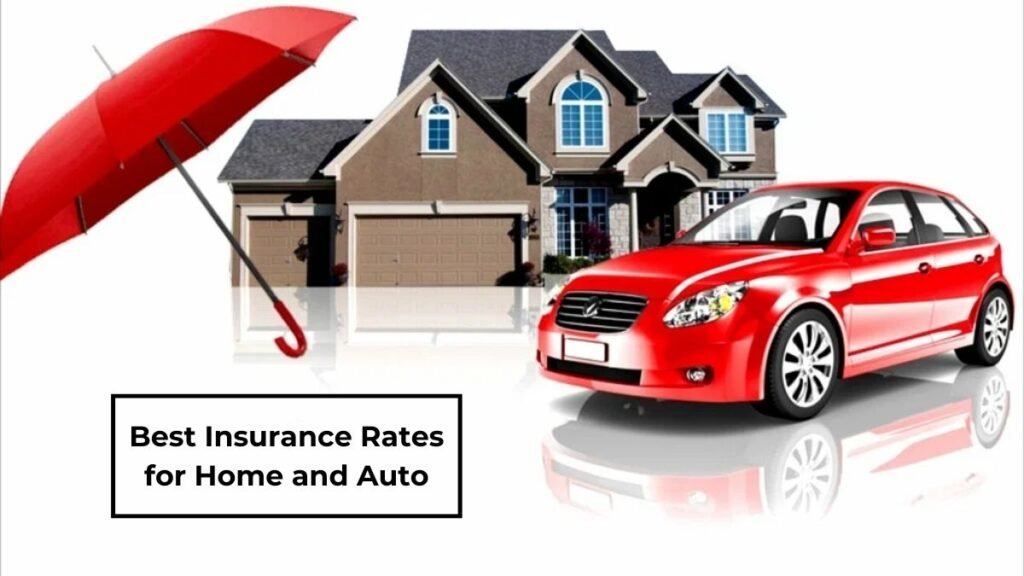Securing the best insurance rates for your home and auto is a smart move that protects your assets without draining your wallet. With home insurance averaging $1,200 per year and auto coverage around $1,500, the stakes are high—finding a great deal can save you hundreds annually while ensuring you’re covered for life’s unexpected twists. Whether you’re insuring a cozy starter home or a reliable daily driver, the right approach can unlock affordable rates tailored to your needs.
This in-depth guide will show you how to find the best insurance rates for your home and car. We’ll cover the factors that shape your premiums, proven strategies to lower costs, and insights into top providers offering competitive deals. You’ll also get a comparison table to evaluate options and an FAQ section to address your questions. Ready to take control of your insurance costs? Let’s dive in.
What Affects Your Insurance Rates
Insurance rates aren’t random—they’re calculated based on risk. Understanding these drivers helps you spot opportunities to save. Here’s what insurers look at:
- Location: Urban areas with high crime or traffic often mean higher rates than rural spots. Weather risks—like hurricanes or floods—also bump up home premiums.
- Personal Profile: Your age, driving record, and credit score (where allowed) play a big role. Clean records and good credit typically lower costs.
- Home and Vehicle Details: A new home with safety features (e.g., smoke detectors) or a safe, affordable car (e.g., a sedan) costs less to insure than an older property or a luxury vehicle.
- Coverage Choices: Higher limits or lower deductibles increase premiums, while minimal coverage cuts costs—but risks leaving you exposed.
Grasping these factors lets you adjust what’s in your control, like adding a car alarm or improving your credit, to nudge rates down.
Strategies to Find the Best Rates
Finding top-notch rates requires a mix of research and savvy shopping. Here’s how to nail it:
- Gather Your Info: Have your home’s rebuild cost, car details (make, model, VIN), and current policies handy. Accurate data ensures accurate quotes.
- Compare Quotes: Use online tools or contact insurers directly for at least three quotes. Standardize coverage levels for a fair comparison.
- Hunt for Discounts: Ask about savings for safe driving, home security systems, or paying in full. Even small discounts add up.
- Consider Bundling: Combining home and auto with one insurer often slashes rates by 5% to 25%. More on this later.
- Adjust Deductibles: Raising your deductible from $500 to $1,000 can lower premiums, if you can handle the upfront cost in a claim.
- Check Smaller Insurers: Regional players or mutual companies sometimes beat big names on price and service.
Timing matters too—shop before your policy renews or after life changes like a move or marriage, which can unlock new savings.
Top Providers for Competitive Rates
While rates vary by location and profile, these five insurers consistently offer strong value for home and auto coverage:
1. Liberty Mutual
Best for Customization
With an “A” AM Best rating, Liberty Mutual offers tailored policies and discounts up to 20% for bundling. Its RightTrack program rewards safe driving with extra savings.
2. Farmers Insurance
Best for Coverage Options
Farmers, rated “A-” by AM Best, provides flexible plans—like eco-friendly home rebuilds—and bundling discounts around 15%. Its local agents add a personal touch.
3. Erie Insurance
Best for Regional Value
Operating in 12 states and D.C., Erie boasts an “A+” AM Best rating and low rates, often with 10%-20% off for bundles. It’s a hidden gem if you’re in its footprint.
4. Amica Mutual
Best for Customer Service
Amica’s “A+” AM Best rating pairs with top J.D. Power scores for satisfaction. Its dividend policies can return 5%-20% of your premium, offsetting costs over time.
5. Nationwide
Best for Multi-Policy Perks
Nationwide’s “A+” AM Best rating comes with bundling savings up to 20%, plus extras like vanishing deductibles for loyal customers.
Comparison Table: Evaluating Your Options
Here’s a table to weigh these providers across four key parameters:
| Provider | Discount Potential | AM Best Rating | Key Strength | Best For |
|---|---|---|---|---|
| Liberty Mutual | Up to 20% | A | Customizable plans | Flexibility seekers |
| Farmers | Around 15% | A- | Broad coverage options | Comprehensive needs |
| Erie | 10%-20% | A+ | Regional affordability | Eligible residents |
| Amica | 5%-20% (dividend) | A+ | Exceptional service | Service-focused buyers |
| Nationwide | Up to 20% | A+ | Bundling perks | Multi-policy savers |
Use this to match your priorities—whether it’s savings, coverage, or support—to the right insurer.
Bundling: A Shortcut to Savings?
Bundling your home and auto insurance is a popular way to score lower rates, but it’s not a one-size-fits-all solution. The perks include a single bill and discounts that can shave significant chunks off your premiums. For a deeper dive into this strategy, see Cheapest Auto and Home Insurance Bundle Deals.
However, bundling’s value depends on your situation. If one insurer’s auto rates are sky-high, a bundle might not beat separate policies from different providers. Always compare bundled versus standalone quotes to confirm you’re getting the best deal.
Avoiding Costly Mistakes
Even smart shoppers can slip up. Watch out for these traps:
- Focusing Only on Price: A cheap rate with weak coverage or poor claims handling isn’t a win.
- Skipping Annual Reviews: Rates change—failing to shop yearly might mean missing better offers.
- Overlooking Discounts: Not asking about savings for things like home upgrades or good grades (for young drivers) leaves money on the table.
- Misjudging Coverage: Underinsuring your home’s rebuild cost or skipping collision on a newer car can backfire.
Stay sharp to ensure your rates stay low and your protection stays solid.
Frequently Asked Questions (FAQ)
Here are answers to common questions about finding the best home and auto insurance rates.
How long does it take to get quotes?
Online tools can deliver quotes in 5-10 minutes. Phone or agent quotes might take 20-30 minutes but offer more detail.
Does shopping around affect my credit?
No, insurance quotes use soft credit pulls, which don’t impact your score. Shop with confidence.
What’s the best time to look for new rates?
Before your policy renews—30-60 days out—gives you leverage. Life events like a new car or home improvements also signal a fresh look.
Can I get good rates with a bad driving record?
Yes, but expect higher premiums. Some insurers specialize in high-risk drivers—shop widely to find them.
How do I know if I’m getting enough coverage?
Estimate your home’s rebuild cost and car’s replacement value, then add liability to cover lawsuits. An agent can fine-tune it.
Are online quotes accurate?
They’re estimates—final rates might shift after underwriting verifies your info. Use them as a starting point.
Conclusion
Finding the best insurance rates for your home and auto is about blending affordability with reliability. By understanding what drives costs, comparing providers like Liberty Mutual, Farmers, Erie, Amica, and Nationwide, and leveraging strategies like bundling or higher deductibles, you can lock in rates that protect without punishing your budget. The table and tips here give you a roadmap—now it’s time to act.
Shop with purpose, ask the right questions, and revisit your options regularly. With this approach, you’ll drive and dwell with confidence, knowing you’ve secured the best rates for your needs. Start your search today and watch the savings roll in!


